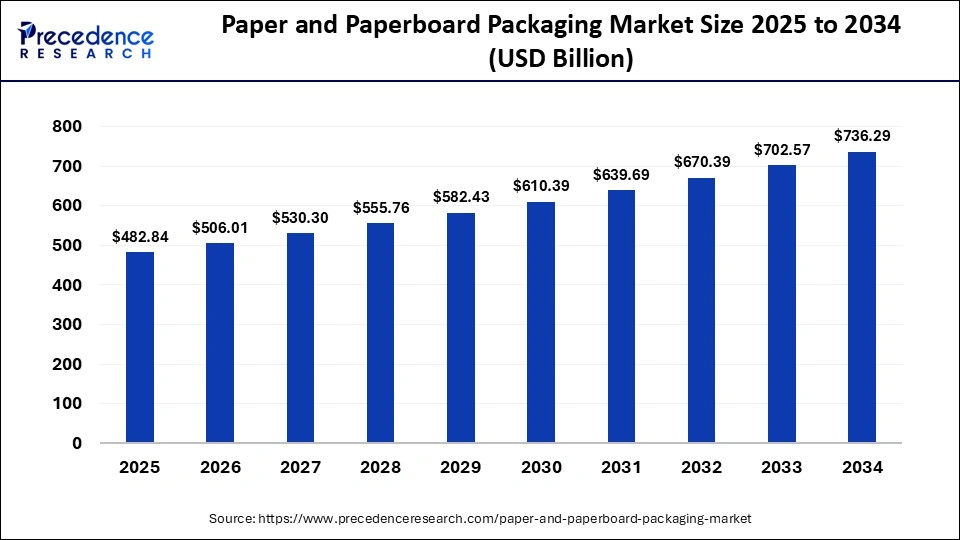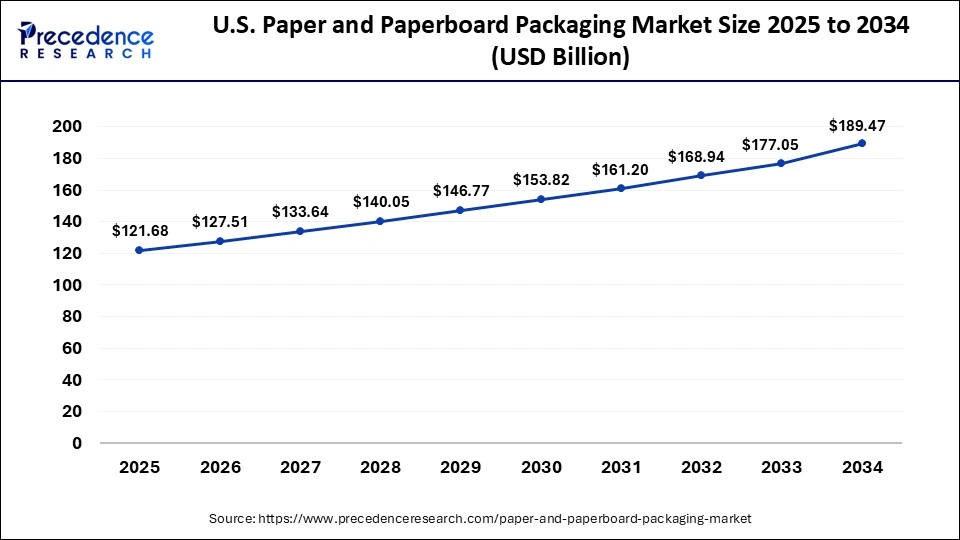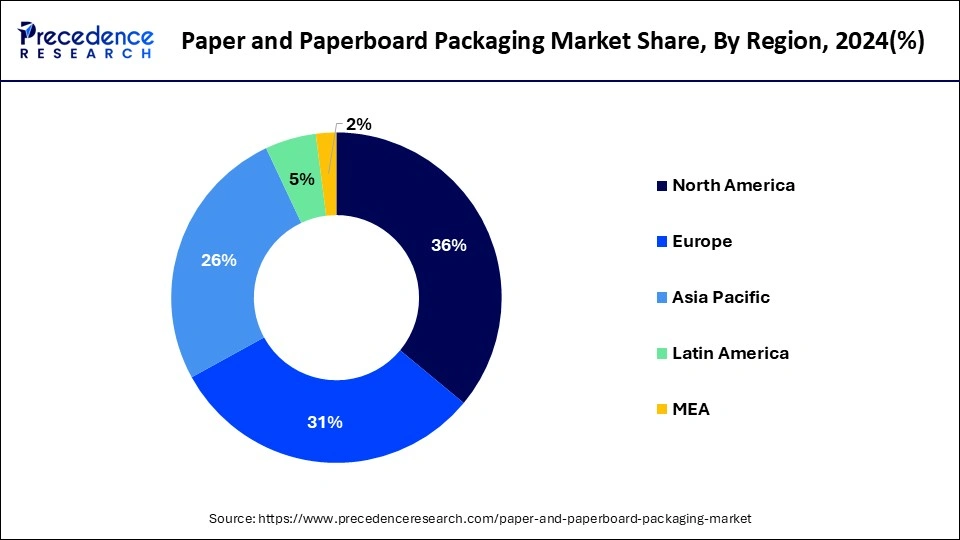January 2025
The global paper and paperboard packaging market size is calculated at USD 439.62 billion in 2024, grew to USD 460.72 billion in 2025 and is predicted to hit around USD 736.29 billion by 2034, expanding at a CAGR of 4.80% between 2024 and 2034. The North America paper and paperboard packaging market size accounted for USD 165.86 billion in 2024 and is anticipated to grow at a fastest CAGR of 4.94% during the forecast year.
The global paper and paperboard packaging market size accounted for USD 439.62 billion in 2024 and is anticipated to reach around USD 736.29 billion by 2034, growing at a CAGR of 4.80% between 2024 and 2034.

The U.S. paper and paperboard packaging market size is calculated at USD 116.10 billion in 2024 and is expected to be worth around USD 189.47 billion by 2034, at a CAGR of 5.01% between 2024 and 2034.

North America has held the largest revenue share 36% in 2023. North America's paper and paperboard packaging market is defined by a strong emphasis on sustainability and eco-friendliness. As consumers increasingly prioritize environmentally responsible packaging, paper and paperboard materials gain prominence. The region witnesses a growing trend of reducing plastic usage and adopting recyclable, biodegradable packaging solutions. Additionally, e-commerce growth during the pandemic has fueled the demand for sturdy and protective paper-based packaging. Personalized packaging, driven by digital printing technologies, is also on the rise, catering to brand differentiation and consumer engagement.

Asia-Pacific is estimated to observe the fastest expansion. The Asia Pacific paper and paperboard packaging market showcases a robust growth trajectory influenced by economic expansion, urbanization, and a burgeoning middle-class population. In this region, the trend of lightweight and sustainable packaging is particularly pronounced, aligning with cost-efficiency and environmental concerns. Customized packaging solutions, especially for food and beverage products, are on the rise to cater to diverse consumer preferences. The adoption of digital printing for branding and marketing purposes is gaining momentum, enhancing product visibility and appealing to the region's tech-savvy consumers.
In the European paper and paperboard packaging market, sustainability remains a dominant trend. European consumers are increasingly eco-conscious, leading to a surge in demand for sustainable packaging solutions. Manufacturers are responding by adopting recyclable, biodegradable, and FSC-certified paper and paperboard materials. Another notable trend is the push for minimalist and functional packaging designs, reflecting European consumers' preference for simplicity and functionality. Additionally, digital printing technologies are gaining ground, enabling customized and visually appealing packaging that resonates with European aesthetics.
Paper and paperboard packaging are versatile and sustainable materials utilized in crafting a diverse array of packaging solutions. Derived from wood pulp, these materials possess the flexibility to be shaped into various forms and sizes, rendering them suitable for a wide spectrum of applications. Within the realm of paper packaging, you'll find items like corrugated boxes, cartons, bags, and labels, while paperboard packaging encompasses materials such as folding cartons, blister cards, and beverage packaging.
One of the chief merits of paper and paperboard packaging lies in its eco-friendliness. These materials are not only recyclable but also biodegradable and sourced from renewable wood pulp. Moreover, they offer exceptional printability, rendering them ideal for branding and marketing purposes. Simultaneously, they excel in safeguarding and preserving products, ensuring their integrity and freshness throughout transportation and storage. It's these qualities that have propelled paper and paperboard packaging to prominence across diverse industries, including food and beverage, healthcare, cosmetics, and consumer goods.
Paper and paperboard packaging represent versatile and sustainable materials extensively employed in diverse packaging solutions across industries. Derived from wood pulp, these materials offer flexibility in shaping and sizing, making them suitable for an array of applications, including corrugated boxes, cartons, labels, and more. Notably, they align with eco-friendly trends due to recyclability, biodegradability, and renewable sourcing.
The global paper & paperboard Packaging market thrives on several growth drivers. The heightened emphasis on sustainability and eco-friendliness has fueled the adoption of paper-based packaging materials. Additionally, the burgeoning e-commerce industry's demand for robust packaging has boosted these materials' utility. Furthermore, increasing consumer awareness of environmental concerns and preferences for recyclable packaging drive market growth.
Industry trends encompass innovative packaging designs and customization to cater to diverse product needs. The incorporation of digital printing technologies for branding and marketing has gained prominence. Eco-friendly packaging solutions and a shift towards lightweight packaging materials are prevailing trends. Furthermore, the COVID-19 pandemic has accelerated the need for hygienic and tamper-evident packaging solutions. Challenges in the paper & paperboard packaging market include addressing competition from alternative materials like plastics. Achieving a balance between sustainability and performance can be complex. Supply chain disruptions and fluctuations in raw material costs pose challenges.
Additionally, stringent regulatory requirements on packaging materials need to be met. Business opportunities abound in innovating sustainable packaging solutions and customizations. The e-commerce sector presents a growth avenue, as does expanding into emerging markets with rising consumer demands. Leveraging digital printing technologies and exploring collaborations for recycling initiatives offer further prospects. Meeting the demand for tamper-evident and hygienic packaging is a valuable opportunity in the current market landscape.
| Report Coverage | Details |
| Market Size in 2024 | USD 460.72 Billion |
| Market Size by 2034 | USD 736.29 Billion |
| Growth Rate from 2023 to 2032 | CAGR of 4.80% |
| Largest Market | North America |
| Base Year | 2023 |
| Forecast Period | 2024 to 2034 |
| Segments Covered | Product Type, End-user, and Region |
| Regions Covered | North America, Europe, Asia-Pacific, Latin America, and Middle East & Africa |
Consumer environmental awareness and e-commerce growth
Increasingly, consumers are prioritizing eco-friendly packaging choices. Paper and paperboard packaging materials are preferred due to their recyclability, biodegradability, and renewable sourcing from wood pulp. Brands that adopt these materials demonstrate their commitment to sustainability, resonating with environmentally conscious consumers. This heightened awareness has not only driven the demand for paper-based packaging but also incentivized businesses to opt for eco-friendly options to meet consumer preferences.
Moreover, the explosive expansion of e-commerce platforms has revolutionized the retail landscape. With more products being shipped directly to consumers' doorsteps, the need for sturdy, protective, and sustainable packaging has never been greater. Paper and paperboard materials offer an ideal solution, as they are lightweight yet durable, ensuring product safety during transit. Their versatility allows for various packaging formats, from corrugated boxes to labels, making them well-suited to the diverse packaging requirements of e-commerce. As consumers continue to embrace online shopping, the demand for paper and paperboard packaging in this sector continues to grow robustly.
Competition from alternative materials
Paper and paperboard packaging face stiff competition from alternative materials like plastics. While paper-based materials offer sustainability benefits, plastics often excel in terms of durability, moisture resistance, and shelf life extension. This competition necessitates continuous innovation to enhance the performance of paper-based packaging to match the attributes of alternative materials.
Moreover, Striking the right balance between packaging performance and sustainability can be challenging. Businesses often grapple with the need to provide packaging that meets stringent performance requirements while minimizing environmental impact. This challenge is particularly relevant when packaging needs to protect sensitive products or ensure a longer shelf life.
Sustainable packaging solutions and digital printing
The global shift towards sustainability and eco-conscious consumer preferences has placed sustainable packaging solutions at the forefront of the paper & paperboard packaging market. Paper and paperboard are inherently eco-friendly materials, offering recyclability, biodegradability, and renewability. As environmental concerns intensify, businesses are increasingly adopting paper-based packaging to align with sustainability goals.
Furthermore, innovations in sustainable packaging, such as reduced packaging waste and minimalistic designs, appeal to consumers and reduce the environmental footprint of packaging materials. This green approach not only meets regulatory requirements but also fosters positive brand image and consumer loyalty.
Moreover, the advent of digital printing technologies has revolutionized branding and marketing in the packaging industry. Paper and paperboard materials are well-suited for digital printing, enabling intricate, customized, and eye-catching designs that enhance product visibility and shelf appeal. This level of personalization and flexibility is particularly valuable for brand differentiation in competitive markets.
Digital printing facilitates rapid prototyping, shorter production runs, and cost-effective variations, making it an ideal choice for businesses seeking dynamic packaging solutions. As consumer expectations for visually appealing and informative packaging rise, the demand for paper and paperboard packaging, combined with digital printing capabilities, continues to surge, driving market growth.
Impacts of COVID-19
The COVID-19 pandemic had a multifaceted impact on the paper & paperboard packaging market. Initially, the pandemic led to disruptions in global supply chains and manufacturing processes, causing uncertainty and delays in the packaging industry. The closure of production facilities and transportation challenges affected the availability of raw materials, impacting production schedules.
However, as the pandemic continued, several key trends emerged that influenced the paper & paperboard packaging market positively. With consumers shifting toward online shopping and e-commerce surging during lockdowns, there was a notable increase in demand for packaging materials suitable for shipping and protecting products. Paper and paperboard packaging, known for their durability and versatility, became essential in ensuring the safe delivery of goods.
Furthermore, the pandemic accelerated the need for tamper-evident and hygienic packaging solutions, particularly in the food and pharmaceutical sectors. Paper-based packaging materials, including labels and cartons, were instrumental in meeting these requirements. Overall, while the initial disruptions posed challenges, the paper & paperboard packaging market adapted to the evolving landscape, emphasizing the critical role of packaging in ensuring product safety and convenience during a global health crisis.
According to the product type, the folding cartons segment has held 53% revenue share in 2023. Folding cartons are flat, paper-based packaging containers that are folded into shape and commonly used for packaging various consumer goods. They are lightweight, customizable, and often feature high-quality printing, making them ideal for branding and marketing purposes. In the paper and paperboard packaging market, folding cartons have seen a trend towards eco-friendly materials and designs as sustainability becomes a key focus. Additionally, customization and personalization options are in demand to create unique and eye-catching packaging solutions.
The corrugated boxes segment is anticipated to expand at a significant CAGR of 7.1% during the projected period. corrugated boxes are sturdy and versatile packaging containers made from corrugated cardboard. They are known for their durability and are commonly used in shipping and transportation due to their protective qualities. In recent trends, there is a growing emphasis on lightweight corrugated materials to reduce shipping costs and environmental impact. Additionally, the e-commerce boom has driven the demand for corrugated boxes, with a focus on designs that enhance unboxing experiences and ensure product safety during transit.
Based on the end user, food and beverages segment held the largest market share of 69% in 2023. In the paper and paperboard packaging market, the food and beverage sector is a prominent end-user. Paperboard cartons, containers, and labels play a vital role in preserving the freshness and integrity of food products. The trends in this segment include a growing demand for sustainable and eco-friendly packaging solutions to align with consumers' green preferences. Additionally, innovative packaging designs that enhance shelf appeal and provide convenience, such as easy-open cartons and single-serve options, are gaining traction as consumer lifestyles evolve.
On the other hand, the personal care segment is projected to grow at the fastest rate over the projected period. The personal care segment in the paper and paperboard packaging market encompasses various products, from cosmetics and skincare to toiletries. Brands in this sector are increasingly adopting paperboard packaging for its eco-friendly image and recyclability. Trends in personal care packaging include minimalist designs, premium finishes, and the use of recycled or biodegradable materials. Additionally, personalized packaging and small-sized, travel-friendly options cater to consumer preferences for convenience and customization in the personal care products they use daily.
Segments Covered in the Report
By Product Type
By End-user
By Geography
For inquiries regarding discounts, bulk purchases, or customization requests, please contact us at sales@precedenceresearch.com
No cookie-cutter, only authentic analysis – take the 1st step to become a Precedence Research client
January 2025
February 2025
May 2024
July 2024